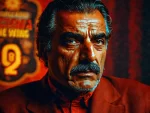Amrish Puri, an Indian actor, was born on June 22, 1932, and passed away on January 12, 2005. He was a prominent character in Indian theatre and cinema. Lala Nihal Chand and Ved Kaur welcomed Amrish Lal Puri into their Punjabi Hindu household in Nawanshahr, Punjab, where he was raised. His siblings were the older brothers Chaman Puri and Madan Puri, the younger brother Harish Puri, and the elder sister Chandrakanta. He was K. L. Saigal's first cousin, the singer and actor.
Early life
He became one of the most well-known and recognisable performers in Indian cinema after appearing in over 450 films. Puri is renowned for her performances in a wide range of film genres, particularly her legendary evil portrayals in both Hindi and foreign cinema. Throughout the 1980s and 1990s, he dominated evil roles; his commanding on-screen persona and unique deep voice set him apart from other villains of the era. Puri worked in mainstream as well as art cinema, appearing in films directed by Govind Nihalani and Shyam Benegal, among others. Out of eight nominations, Puri took home three Filmfare Awards for Best Supporting Actor. In addition, he is the most nominated villain for the Filmfare Award.
He had acted in films in Punjabi, Telugu, Kannada, Tamil, Malayalam, and Marathi languages, although his career was primarily in Hindi. Vidhaata (1982), Shakti (1982), Hero (1983), Meri Jung (1985), Nagina (1986), Mr. India (1987), Shahenshah (1988), Ram Lakhan (1989), Tridev (1990), Ghayal (1990), Saudagar (1991), Thalapathi (1991), Tahalka (1992), Damini (1993), Karan Arjun (1995), Kaalapani (1996), Jeet (1996), Koyla (1997), Baadshah (1999), Gadar: Ek Prem Katha (2001), and Nayak: The Real Hero (2001) are some of the most well-known villainous roles that Puri played. Puri's portrayal as Mogambo, the primary antagonist in Shekhar Kapur's 1987 film Mr. India, is regarded as one of the best villain performances in Indian cinema history.
Puri was a very successful actor who also starred in good supporting parts. He was recognised with three Filmfare Awards for Best Supporting Actor. Phool Aur Kaante, Dilwale Dulhaniya Le Jayenge, Gardish, Ghatak (1996), Diljale (1996), Pardes (1997), Virasat (1997), China Gate (1998), Badal (2000), Mujhe Kucch Kehna Hai (2001), Mujhse Shaadi Karogi (2004), and Hulchul (2004) are a few of his noteworthy good roles.
He is most recognised to Western viewers for his roles as Khan in Richard Attenborough's Gandhi (1982) and Mola Ram in Steven Spielberg's Hollywood production Indiana Jones and the Temple of Doom (1984). Vardhan Puri, his grandson, is an actor in Indian cinema. He wrote and performed in a film called Amrish Puri Films, which bears Puri's name.
Career
Between 1967 and 2005, Puri appeared in over 450 films, the most of which were economically successful. He was also one of Bollywood's most popular villains. However, his formative years were characterised by unrelenting hardship, and it took him until he was over fifty years old to play a major role in a motion picture. Puri's family was involved in the film industry. Puri's first cousin was the singer and actor K. L. Saigal, one of the pioneers of Indian film. Inspired by their cousin's success, Puri's elder brothers, Chaman and Madan Puri, relocated to Mumbai in the 1950s to pursue careers as character performers in films.
Puri also travelled to Mumbai in the middle of the 1950s to try his luck, but he didn't pass the initial screening. Nevertheless, he was able to secure a reliable position with the government-run Employees State Insurance Corporation (ESIC) and fulfilled his acting passion by joining an amateur theatre group, or natak mandali. His company frequently presented plays by Satyadev Dubey at the Prithvi Theatre. As a theatre performer, he ultimately rose to fame and was even awarded the Sangeet Natak Akademi Award in 1979. At the comparatively late age of 40 (forty), this stage notoriety quickly led to work in television commercials and finally to film roles.
Death
After being taken to the Hinduja Hospital on December 27, 2004, Puri underwent brain surgery to treat his unusual form of blood cancer, myelodysplastic syndrome. Due to his illness, blood had to be often removed from the cerebral area of the brain. Eventually, he fell into a coma, and on January 12, 2005, at 7:30 a.m., he passed away. His remains were taken to his home so that people might pay their final respects. On January 13, 2005, a funeral was held at the Shivaji Park Crematorium.

